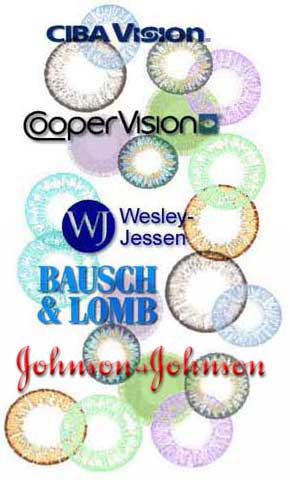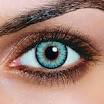Contact Lenses-Learn More...
We offer a wide range of contact lenses to fit your needs including contact lens exams and fittings. Our offering of contact lenses from the major manufacturers, include disposable soft contact, bifocal/multifocal, toric, and colored lenses. Whether you wear daily, weekly or monthly disposables, or conventional (vial) lenses, check out our selection of lenses that fit your needs.
A good contact lens fit starts with a thorough eye exam to ensure the most up-to-date prescription and rule out any pre-existing conditions that could interfere with contact lens wear.
We will determine the best fitting lens based on your lifestyle needs, the shape and health of your eye. In most cases, you'll have the opportunity to try lenses on the same day as your exam. You can even go home with a few samples before making a final decision.
We follow up the initial fitting and then make any necessary changes in fit or materials to get you the best possible fit. We teach all our patients proper contact lens care and also possible consequences if proper care is not taken. Then we continue with long-term follow-up to monitor the condition of the lenses and to ensure that proper hygiene is being maintained.
Which Contact Lens Is Right for You?
First, your contacts must address the problem that is prompting you to wear lenses in the first place. Your contact lenses must provide good vision by correcting your myopia, hyperopia, astigmatism, or some combination of those vision problems.
Second, the lens must fit your eye. To do that, lenses come in tens of thousands of combinations of diameter and curvature. Of course, not every lens brand comes in every "size."
Our Optometrists are skilled in evaluating your eye's physiology, and your eyesight, to determine which lens best satisfies the two criteria above.
Third, you may have another medical need that drives the choice of lens. For example, our Optometrists might pick a particular lens if your eyes tend to be dry.
Finally, consider your "wish list" of contact lens features — colors, for example, or overnight wear.
When you and our optometrist decide on the right lens for you, you'll be given a contact lens prescription and will be able to buy a supply of lenses.
Eye Exams for Contact Lenses
A routine exam won't provide some of the measurements and testing that are required to determine if your eyes are suitable for contact lens wear, and to generate your contact lens Rx.
For many people, contact lenses provide greater convenience and more satisfying vision correction than eyeglasses. Here's what's involved in a typical contact lens exam and fitting:
A comprehensive eye exam comes first
Before being fit with contact lenses, a comprehensive eye exam is performed. In this exam, our doctor determines your prescription for corrective lenses (just a glasses prescription at this point) and checks for any eye health problems or other issues that may interfere with successful contact lens wear.
If all looks good during your eye exam, the next step is a contact lens consultation and fitting.
What to expect during a contact lens fitting
The first step in a contact lens fitting is a consideration of your lifestyle and your preferences regarding contact lenses, such as whether you might want to change your eye color with color contact lenses or if you're interested in options such as daily disposables or overnight wear. Although most people choose soft contact lenses, the advantages and disadvantages of rigid gas permeable (GP) lenses will likely be discussed as well.
If you are over age 40 and need bifocals, our doctor and contact lens specialist will discuss ways to deal with this need, including multifocal contact lenses and monovision (a prescribing technique where one contact lens corrects your distance vision and the other lens corrects your near vision).
Contact lens measurements
Just as one shoe size doesn't fit all feet, one contact lens size doesn't fit all eyes. If the curvature of a contact lens is too flat or too steep for your eye's shape, you may experience discomfort or even damage to your eye. Measurements that will be taken to determine the best contact lens size and design for your eyes include:
- Corneal curvature: An instrument called a keratometer is used to measure the curvature of your eye's clear front surface (cornea). This measurement helps your doctor select the best curve and diameter for your contact lenses.
- If your eye's surface is found to be somewhat irregular because of astigmatism, you may require a special lens design of lens known as a "toric" contact lens. At one time, only gas permeable contact lenses could correct for astigmatism. But there are now many brands of soft toric lenses, which are available in disposable, multifocal, extended wear and colored versions.
- In some cases, a detailed mapping of the surface of your cornea (called corneal topography) may be done. Corneal topography provides extremely precise details about surface characteristics of the cornea and creates a surface "map" of your eye, with different contours represented by varying colors.
- Pupil and iris size: The size of your pupil and iris (the colored part of your eye) can play an important role in determining the best contact lens design, especially if you are interested in GP contact lenses. These measurements may be taken with a lighted instrument called a biomicroscope (also called a slit lamp) or simply with a hand-held ruler or template card.
- Tear film evaluation: To be successful wearing contact lenses, you must have an adequate tear film to keep the lenses and your cornea sufficiently moist and hydrated. This test may be performed with a liquid dye placed on your eye so your tears can be seen with a slit lamp, or with a small paper strip placed under your lower lid to see how well your tears moisten the paper. If you have dry eyes, contact lenses may not be right for you. Also, the amount of tears you produce may determine which contact lens material will work best for you.
Toric Contact Lenses for Astigmatism
If you have astigmatism - a common condition where the eye isn't perfectly round, but more football- or egg-shaped - then you'll need a special design of contact lenses called "toric" lenses for clear vision.
Toric contact lenses are available in both soft and rigid gas permeable (RGP or GP) lens materials. Most contact lens wearers who need toric contacts choose soft toric lenses.
Bifocal and Multifocal Contact Lenses
Bifocal and multifocal contact lenses are designed to give you good vision when you reach your 40s. Beginning at this age, you may need to hold reading material - like a menu or newspaper - farther from your eyes to see it clearly. This condition is called "presbyopia."
Bifocal and multifocal contact lenses are available in both soft and rigid gas permeable (GP) materials.
Bifocals and Multifocals - What's the difference?
Bifocal contacts lenses (like bifocal eyeglass lenses) have two powers - one for seeing clearly far away and one for seeing clearly up close. Multifocal contact lenses, like progressive eyeglass lenses, have a range of powers for seeing clearly far away, up close and everywhere in between. ("Multifocal" is also a catch-all term for all lenses with more than one power, including bifocals.)
Trial lenses
In many cases, trial lenses will be used to verify the contact lens selection. Lenses will be placed on your eye and our doctor will use the slit lamp to evaluate the position and movement of the lenses as you blink and look in different directions. You will also be asked how the lenses feel.
You'll typically need to wear these trial lenses at least 15 minutes so that any initial excess tearing of the eye stops and your tear film stabilizes. If all looks good, you will be given instructions on how to care for your lenses and how long to wear them. You will also receive training on how to handle, apply and remove the lenses.
Follow-up visits confirm the fit and safety
Your contact lens fitting will involve a number of follow-up visits so our optometrist can confirm the lenses are fitting your eyes properly and that your eyes are able to tolerate contact lens wear. A dye (like the one used to evaluate your tear film) may be used to see if the lenses are causing damage to your cornea or making your eyes become too dry.
Often, our optometrist will be able to see warning signs before you are aware a problem with your contact lens wear is developing. If such warning signs are evident in your follow-up visits, a number of things may be recommended, including trying a different lens or lens material, using a different lens care method, or adjusting your contact lens wearing time. In occasional cases, it may be necessary to discontinue contact lens wear altogether.
Your contact lens prescription
After finding a contact lens that fits properly, is comfortable for you, and provides good vision, our optometrist will then be able to write a contact lens prescription for you. This prescription will designate the contact lens power, the curvature of the lens (called the base curve), the lens diameter, and the lens name and manufacturer. In the case of GP contact lenses, additional specifications may also be included.
Routine contact lens exams
Regardless of how often or how long you wear your contact lenses, your eyes should be examined at least once a year to make sure your eyes are continuing to tolerate contact lens wear and show no signs of ill effects from the lenses.
For more information on contact lenses or eye exams, visit All About Vision®.
Article ©2009 Access Media Group LLC. All rights reserved. Reproduction other than for one-time personal use is strictly prohibited.





